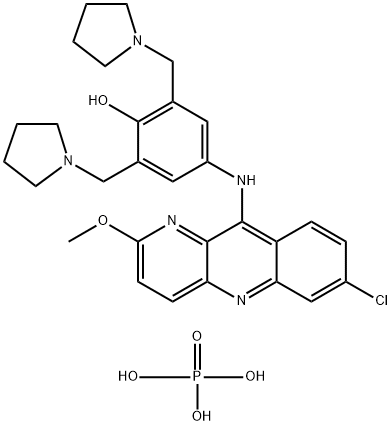Amodiaquin dihydrochloride dihydrate
Synonym(s):4-([7-Chloro-4-quinolinyl]amino)-2-([diethylamino]methyl)phenol;Amodiaquin dihydrochloride dihydrate
- CAS NO.:6398-98-7
- Empirical Formula: C20H25Cl2N3O2
- Molecular Weight: 410.34
- MDL number: MFCD09260307
- EINECS: 642-210-0
- SAFETY DATA SHEET (SDS)
- Update Date: 2025-12-23 13:58:55

What is Amodiaquin dihydrochloride dihydrate?
Chemical properties
Light yellow powder
The Uses of Amodiaquin dihydrochloride dihydrate
antimalarial
The Uses of Amodiaquin dihydrochloride dihydrate
An anti-malarial quinoline derivative that acts as an histamine N-methyltransferase inhibitor
brand name
Camoquin (Parke-Davis).
Biological Activity
Amodiaquine is a potent, non-competitive inhibitor of histamine N-methyl transferase with estimated Ki of 18.6 nM. It is also used as an antimalarial and anti-inflammatory agent.
in vivo
In vivo administration of a small dose amodiaquine dramatically enhanced the effect of histamine on the gastric secretion in dogs. Amodiaquine prevents severe hepatic injury and high lethality in P. acnes-primed and LPS-induced hepatitis mice. Its treatment enhances the elevation of histamine in the liver of P. acnes-primed and LPS-induced hepatitis mice without accompanying tele-methyl histamine elevation.
Properties of Amodiaquin dihydrochloride dihydrate
| RTECS | GO7300100 |
| storage temp. | Inert atmosphere,Room Temperature |
| solubility | Soluble in DMSO or methanol |
| form | neat |
| form | Solid |
| color | White to Yellow to Orange |
| λmax | 342nm(MeOH)(lit.) |
| Merck | 14,572 |
| Stability: | Hygroscopic |
| CAS DataBase Reference | 6398-98-7(CAS DataBase Reference) |
Safety information for Amodiaquin dihydrochloride dihydrate
| Signal word | Warning |
| Pictogram(s) |
 Exclamation Mark Irritant GHS07 |
| GHS Hazard Statements |
H315:Skin corrosion/irritation H319:Serious eye damage/eye irritation H335:Specific target organ toxicity, single exposure;Respiratory tract irritation |
| Precautionary Statement Codes |
P261:Avoid breathing dust/fume/gas/mist/vapours/spray. P271:Use only outdoors or in a well-ventilated area. P280:Wear protective gloves/protective clothing/eye protection/face protection. P312:Call a POISON CENTER or doctor/physician if you feel unwell. P302+P352:IF ON SKIN: wash with plenty of soap and water. P304+P340:IF INHALED: Remove victim to fresh air and Keep at rest in a position comfortable for breathing. P305+P351+P338:IF IN EYES: Rinse cautiously with water for several minutes. Remove contact lenses, if present and easy to do. Continuerinsing. P403+P233:Store in a well-ventilated place. Keep container tightly closed. |
Computed Descriptors for Amodiaquin dihydrochloride dihydrate
New Products
Indole Methyl Resin tert-butyl 9-methoxy-3-azaspiro[5.5]undecane-3-carboxylate Boc-His(Boc)-OH 2-CTC Resin 4-Chloro-7-tosy1-7Hpyrrolo[2,3-d]pyrimidine 5,7-Dibromo-1H-indole 2,5-dichloro-N-hydroxy-4,6-dimethylpyridine-3-carboximidamide 2,2-Dimethoxy-7-azaspiro[3.5]nonane hydrochloride 4-chloromethyl-5-methyl-1,3-dioxol-2-one (DMDO-Cl) R-2-BENZYLOXY PROPIONIC ACID 1,1’-CARBONYLDIIMIDAZOLE 1,1’-CARBONYLDI (1,2-4 TRIAZOLE) N-METHYL INDAZOLE-3-CARBOXYLIC ACID 4-((2-hydroxyethyl)thio)benzoic acid 1-(TERT-BUTOXYCARBONYL)-2-PYRROLIDINONE Methyl 6-methylnicotinate 3-Pyridineacrylic acid tert-Butyl carbazate TETRAHYDRO-2H-PYRAN-3-OL 2-((4-morpholinophenylamino) (methylthio) methylene) malononitrile 3-(4-morpholinophenylamino)-5-amino-1H-pyrazole-4-carbonitrile 2,4-dihydroxybenzaldehyde 1,3-Diethyl-1,3-Diphenylurea Methyl 2-methylquinoline-6-carboxylateRelated products of tetrahydrofuran








You may like
-
 Amodiaquine Dihydrochloride Dihydrate CAS 6398-98-7View Details
Amodiaquine Dihydrochloride Dihydrate CAS 6398-98-7View Details
6398-98-7 -
 Amodiaquin diHCl dihydrate 98% CAS 6398-98-7View Details
Amodiaquin diHCl dihydrate 98% CAS 6398-98-7View Details
6398-98-7 -
 Amodiaquine hydrochloride CAS 6398-98-7View Details
Amodiaquine hydrochloride CAS 6398-98-7View Details
6398-98-7 -
 Amodiaquine HCL API, 25Kg, 98%View Details
Amodiaquine HCL API, 25Kg, 98%View Details
6398-98-7 -
 Amodiaquine Hcl ApiView Details
Amodiaquine Hcl ApiView Details
86-42-0 -
 Amodiaquine HCL APIView Details
Amodiaquine HCL APIView Details
86-42-0 -
 Pyridine 99.5% HPLC /UV SpectroscopyView Details
Pyridine 99.5% HPLC /UV SpectroscopyView Details
110-86-1 -
 Thiourea 99% ARView Details
Thiourea 99% ARView Details
62-56-6
